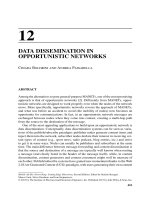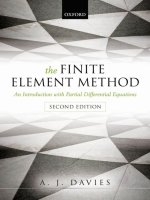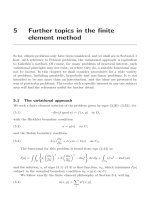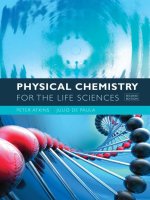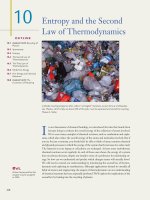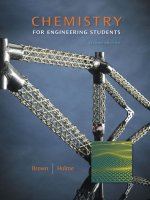Ebook Chemistry for engineering students (2nd edition) Part 1
Bạn đang xem bản rút gọn của tài liệu. Xem và tải ngay bản đầy đủ của tài liệu tại đây (7.17 MB, 348 trang )
Chemistry for
Engineering Students
This page intentionally left blank
Chemistry for
Engineering Students
Lawrence S. Brown
Texas A&M University
Thomas A. Holme
Iowa State University
Australia • Brazil • Japan • Korea • Mexico • Singapore • Spain • United Kingdom • United States
SECOND
EDITION
Chemistry for Engineering Students,
Second Edition
Lawrence S. Brown, Thomas A. Holme
Publisher: Mary Finch
Acquisitions Editor: Charles Hartford
Developmental Editor: Rebecca Heider
Assistant Editor: Ashley Summers
© 2011, 2006 Brooks/Cole, Cengage Learning
ALL RIGHTS RESERVED. No part of this work covered by the copyright herein
may be reproduced, transmitted, stored, or used in any form or by any means
graphic, electronic, or mechanical, including but not limited to photocopying,
recording, scanning, digitizing, taping, Web distribution, information networks,
or information storage and retrieval systems, except as permitted under
Section 107 or 108 of the 1976 United States Copyright Act, without the prior
written permission of the publisher.
Editorial Assistant: Jon Olafsson
Senior Media Editor: Lisa Weber
Marketing Manager: Nicole Hamm
Marketing Assistant: Kevin Carroll
Marketing Communications Manager: Linda Yip
For product information and technology assistance, contact us at
Cengage Learning Customer & Sales Support, 1-800-354-9706.
For permission to use material from this text or product,
submit all requests online at www.cengage.com/permissions.
Further permissions questions can be e-mailed to
Content Project Manager: Teresa L. Trego
Creative Director: Rob Hugel
Art Director: John Walker
Print Buyer: Judy Inouye
Rights Acquisitions Account Manager, Text:
Timothy Sisler
Rights Acquisitions Account Manager, Image:
Don Schlotman
Production Service: Pre-Press PMG
Text Designer: tani hasegawa
Photo Researcher: Kelly Franz
OWL Producers: Stephen Battisti, Cindy Stein,
and David Hart in the Center for Educational
Software Development at the University
of Massachusetts, Amherst, and Cow Town
Productions
Library of Congress Control Number: 2009935278
Student Edition:
ISBN-13: 978-1-4390-4791-0
ISBN-10: 1-4390-4791-X
Brooks/Cole
20 Davis Drive
Belmont, CA 94002-3098
USA
Cengage Learning is a leading provider of customized learning solutions with
office locations around the globe, including Singapore, the United Kingdom,
Australia, Mexico, Brazil, and Japan. Locate your local office at
www.cengage.com/global.
Copy Editor: James Corrick
Illustrator: Pre-Press PMG
Cengage Learning products are represented in Canada by Nelson Education, Ltd.
Cover Designer: tani hasegawa
Cover Image: Frame Cover Image by Greg
Neumaier, Frame Courtesy of Delta 7:
Delta 7 has manufactured the first high
performance lightweight mountain bike
frame featuring the patented IsoTruss
carbon fiber and Kevlar spider web-like
open lattice tube design. The high performance hardtail bike frame is handcrafted
in the United States and weighs only
2.74 pounds. The Arantix is an extreme
hardtail mountain bike with an unparalleled strength-to-weight ratio resulting
in an ultra stiff and responsive bike. Inset
graphene molecule: Jannik Meyer
Compositor: Pre-Press PMG
Printed in the United States of America
1 2 3 4 5 6 7 13 12 11 10 09
To learn more about Brooks/Cole, visit www.cengage.com/brookscole
Purchase any of our products at your local college store or at our preferred
online store www.ichapters.com.
About the Authors
Larry Brown is a Senior Lecturer and coordinator
for the General Chemistry for Engineering Students
course at Texas A&M University. He received his B.S.
in 1981 from Rensselaer Polytechnic Institute, and
his M.A. in 1983 and Ph.D. in 1986 from Princeton
University. During his graduate studies, Larry spent
a year working in what was then West Germany. He
was a Postdoctoral Fellow at the University of Chicago
from 1986 until 1988, at which time he began his
faculty career at Texas A&M. Over the years, he has
taught more than 10,000 general chemistry students,
most of them engineering majors. Larry’s excellence in teaching has been recognized
by awards from the Association of Former Students at Texas A&M at both the
College of Science and University levels. A version of his class has been broadcast
on KAMU-TV, College Station’s PBS affiliate. From 2001 to 2004, Larry served
as a Program Officer for Education and Interdisciplinary Research in the Physics
Division of the National Science Foundation. He also coordinates chemistry courses
for Texas A&M’s engineering program in Doha, Qatar. When not teaching chemistry,
he enjoys road bicycling and coaching his daughter Stephanie’s soccer team.
Tom Holme is a Professor of Chemistry at Iowa State
University and Director of the ACS Examinations
Institute. He received his B.S. in 1983 from Loras
College, and his Ph.D. in 1987 from Rice University.
He began his teaching career as a Fulbright Scholar in
Zambia, Africa and has also lived in Jerusalem, Israel
and Suwon, South Korea. His research interests lie
in computational chemistry, particularly as applied to
understanding processes important for plant growth.
He is also active chemical education research and has
been involved with the general chemistry for engineers
course at both Iowa State University and at the University of Wisconsin–Milwaukee
where he was a member of the Chemistry and Biochemistry Department. He has
received several grants from the National Science Foundation for work in assessment
methods for chemistry, and the “Focus on Problem Solving” feature in this textbook grew
out of one of these projects. He served as an Associate Editor on the encyclopedia
“Chemistry Foundations and Applications.” In 1999 Tom won the ACS’s Helen Free
Award for Public Outreach for his efforts doing chemical demonstrations on live
television in the Milwaukee area.
v
Brief Contents
1
Introduction to Chemistry 1
OPENING INSIGHT THEME:
CLOSING INSIGHT THEME:
2
CLOSING INSIGHT THEME:
CLOSING INSIGHT THEME:
Stoichiometry
CLOSING INSIGHT THEME:
Gases
CLOSING INSIGHT THEME:
7
Air Pollution 126
Gas Sensors 148
Incandescent and Fluorescent Lights
CLOSING INSIGHT THEME:
Modern Light Sources: LEDs and Lasers
159
192
Chemical Bonding and Molecular Structure 200
Materials for Biomedical Engineering 201
Molecular Scale Engineering for Drug
Delivery 234
Molecules and Materials 240
OPENING INSIGHT THEME:
CLOSING INSIGHT THEME:
Carbon 241
The Invention of New Materials
272
Energy and Chemistry 280
OPENING INSIGHT THEME:
CLOSING INSIGHT THEME:
vi
117
OPENING INSIGHT THEME:
CLOSING INSIGHT THEME:
9
Gasoline and Other Fuels 100
Alternative Fuels and Fuel Additives
The Periodic Table and Atomic Structure 158
OPENING INSIGHT THEME:
8
91
125
OPENING INSIGHT THEME:
6
Explosions 65
Explosives and Green Chemistry
99
OPENING INSIGHT THEME:
5
Polymers 31
Polyethylene 56
Molecules, Moles, and Chemical Equations 64
OPENING INSIGHT THEME:
4
24
Atoms and Molecules 30
OPENING INSIGHT THEME:
3
Aluminum 2
Material Selection and Bicycle Frames
Energy Use and the World Economy
Batteries 308
281
10
Entropy and the Second Law
of Thermodynamics 318
CLOSING INSIGHT THEME:
Recycling of Plastics 319
The Economics of Recycling
Chemical Kinetics
347
OPENING INSIGHT THEME:
Ozone Depletion 348
Tropospheric Ozone 379
OPENING INSIGHT THEME:
11
CLOSING INSIGHT THEME:
12
Chemical Equilibrium
OPENING INSIGHT THEME:
CLOSING INSIGHT THEME:
13
391
Concrete Production and Weathering
Borates and Boric Acid 427
392
Electrochemistry 436
OPENING INSIGHT THEME:
CLOSING INSIGHT THEME:
14
335
Corrosion 437
Corrosion Prevention 465
Nuclear Chemistry 474
OPENING INSIGHT THEME:
CLOSING INSIGHT THEME:
Cosmic Rays and Carbon Dating 475
Modern Medical Imaging Methods 498
Appendixes
A
B
C
D
E
F
G
H
International Table of Atomic Weights 507
Physical Constants 509
Electron Configurations of Atoms in the Ground State 510
Specific Heats and Heat Capacities of Some Common Substances
Selected Thermodynamic Data at 298.15 K 512
Ionization Constants of Weak Acids at 25°C 518
Ionization Constants of Weak Bases at 25°C 520
Solubility Product Constants of Some Inorganic Compounds
at 25°C 521
I Standard Reduction Potentials in Aqueous Solution
at 25°C 523
J Answers to Check Your Understanding Exercises 526
K Answers to Odd-Numbered End-of-Chapter Exercises 529
511
Brief Contents
vii
Contents
Preface
xix
Student Introduction
1
xxvii
Introduction to Chemistry 1
1.1 INSIGHT INTO Aluminum
1.2 The Study of Chemistry
2
4
6
1.3 The Science of Chemistry: Observations and Models
Observations in Science 9
Interpreting Observations 10
Models in Science 11
1.4 Numbers and Measurements in Chemistry
at Berkeley
National Laboratory, and the University of California
Courtesy of Zettl Research Group, Lawrence Berkeley
The Macroscopic Perspective 4
The Microscopic or Particulate Perspective
Symbolic Representation 8
Units 13
Numbers and Significant Figures
16
1.5 Problem Solving in Chemistry and Engineering
Using Ratios 18
Ratios in Chemistry Calculations 19
Conceptual Chemistry Problems 21
Visualization in Chemistry 22
1.6 INSIGHT INTO Material Selection and
Bicycle Frames 24
Focus on Problem Solving 25
Summary 26
Key Terms 26
Problems and Exercises 27
2
Atoms and Molecules 30
2.1 INSIGHT INTO Polymers
31
2.2 Atomic Structure and Mass 33
Fundamental Concepts of the Atom 33
Atomic Number and Mass Number 34
Isotopes 34
Atomic Symbols 35
Atomic Masses 36
2.3 Ions
38
Mathematical Description 38
Ions and Their Properties 39
viii
12
18
9
2.4 Compounds and Chemical Bonds
40
2.5 The Periodic Table
© Cengage Learning/Charles D. Winters
Chemical Formulas 40
Chemical Bonding 42
44
Periods and Groups 44
Metals, Nonmetals, and Metalloids
46
2.6 Inorganic and Organic Chemistry
47
Inorganic Chemistry—Main Groups and Transition Metals
Organic Chemistry 49
Functional Groups 52
2.7 Chemical Nomenclature
48
53
Binary Systems 53
Naming Covalent Compounds 53
Naming Ionic Compounds 54
2.8 INSIGHT INTO Polyethylene
56
Focus on Problem Solving 58
Summary 59
Key Terms 59
Problems and Exercises 60
3
Molecules, Moles, and Chemical Equations 64
3.1 INSIGHT INTO Explosions
65
3.2 Chemical Formulas and Equations
© Cengage Learning/Charles D. Winters
67
Writing Chemical Equations 67
Balancing Chemical Equations 68
3.3 Aqueous Solutions and Net Ionic Equations
Solutions, Solvents, and Solutes 72
Chemical Equations for Aqueous Reactions
Acid–Base Reactions 78
72
76
3.4 Interpreting Equations and the Mole
81
Interpreting Chemical Equations 81
Avogadro’s Number and the Mole 82
Determining Molar Mass 83
3.5 Calculations Using Moles and Molar Masses
84
Elemental Analysis: Determining Empirical and Molecular Formulas
Molarity 88
Dilution 90
3.6 INSIGHT INTO Explosives and Green Chemistry
86
91
Focus on Problem Solving 92
Summary 93
Key Terms 93
Problems and Exercises 93
4
Stoichiometry 99
4.1 INSIGHT INTO Gasoline and Other Fuels
4.2 Fundamentals of Stoichiometry
100
103
Obtaining Ratios from a Balanced Chemical Equation
104
Contents
ix
4.3 Limiting Reactants
108
4.4 Theoretical and Percentage Yields 113
4.5 Solution Stoichiometry 114
4.6 INSIGHT INTO Alternative Fuels and Fuel
Additives 117
Focus on Problem Solving 118
Summary 119
Key Terms 119
Problems and Exercises 119
5
Gases 125
5.1 INSIGHT INTO Air Pollution
Properties of Gases
5.2 Pressure
126
128
129
Measuring Pressure 130
Units of Pressure 130
5.3 History and Application of the Gas Law
Units and the Ideal Gas Law
132
135
5.4 Partial Pressure
136
5.5 Stoichiometry of Reactions Involving Gases
STP Conditions
139
140
5.6 Kinetic–Molecular Theory and Ideal Versus Real
Gases
141
Postulates of the Model 141
Real Gases and Limitations of the Kinetic Theory
Correcting the Ideal Gas Equation 146
5.7 INSIGHT INTO Gas Sensors
145
148
Capacitance Manometer 148
Thermocouple Gauge 149
Ionization Gauge 149
Mass Spectrometer 151
Focus on Problem Solving 151
Summary 152
Key Terms 152
Problems and Exercises 152
6
The Periodic Table and Atomic
Structure 158
6.1 INSIGHT INTO Incandescent and Fluorescent
Lights 159
6.2 The Electromagnetic Spectrum
The Wave Nature of Light 161
The Particulate Nature of Light 165
6.3 Atomic Spectra
The Bohr Atom
x
Contents
172
169
161
6.4 The Quantum Mechanical Model of the Atom
Potential Energy and Orbitals
Quantum Numbers 176
Visualizing Orbitals 178
173
175
6.5 The Pauli Exclusion Principle and Electron
Configurations
181
Orbital Energies and Electron Configurations
Hund’s Rule and the Aufbau Principle 183
182
6.6 The Periodic Table and Electron
Configurations 185
6.7 Periodic Trends in Atomic Properties
187
Atomic Size 187
Ionization Energy 188
Electron Affinity 191
6.8 INSIGHT INTO Modern Light Sources: LEDs
and Lasers 192
Focus on Problem Solving 194
Summary 194
Key Terms 195
Problems and Exercises 195
7
Chemical Bonding and Molecular
Structure 200
7.1 INSIGHT INTO Materials for Biomedical
Engineering 201
7.2 The Ionic Bond 202
Formation of Cations 202
Formation of Anions 204
7.3 The Covalent Bond
207
Chemical Bonds and Energy 207
Chemical Bonds and Reactions 209
Chemical Bonds and the Structure of Molecules
7.4 Electronegativity and Bond Polarity
209
211
Electronegativity 212
Bond Polarity 213
7.5 Keeping Track of Bonding: Lewis Structures
Resonance
215
220
7.6 Orbital Overlap and Chemical Bonding
221
7.7 Hybrid Orbitals
224
7.8 Shapes of Molecules 226
7.9 INSIGHT INTO Molecular Scale Engineering for
Drug Delivery 234
Focus on Problem Solving 235
Summary 235
Key Terms 236
Problems and Exercises 236
Contents
xi
8
Molecules and Materials 240
8.1 INSIGHT INTO Carbon
241
8.2 Condensed Phases—Solids
243
8.3 Bonding in Solids: Metals, Insulators,
and Semiconductors 249
Models of Metallic Bonding 249
Band Theory and Conductivity 251
Semiconductors 252
8.4 Intermolecular Forces
256
Forces Between Molecules 256
Dispersion Forces 256
Dipole–Dipole Forces 258
Hydrogen Bonding 258
8.5 Condensed Phases—Liquids
261
Vapor Pressure 261
Boiling Point 263
Surface Tension 264
8.6 Polymers
265
Addition Polymers 266
Condensation Polymers 268
Copolymers 270
Physical Properties 271
Polymers and Additives 272
8.7 INSIGHT INTO The Invention
of New Materials
272
Focus on Problem Solving 274
Summary 275
Key Terms 275
Problems and Exercises 275
9
Energy and Chemistry 280
9.1 INSIGHT INTO Energy Use and the World
Economy 281
9.2 Defining Energy
284
Forms of Energy 284
Heat and Work 285
Energy Units 285
9.3 Energy Transformation and Conservation
of Energy
286
Waste Energy
288
9.4 Heat Capacity and Calorimetry
Heat Capacity and Specific Heat
Calorimetry 293
9.5 Enthalpy
295
Defining Enthalpy 295
DH of Phase Changes 296
xii
Contents
289
289
Vaporization and Electricity Production 298
Heat of Reaction 299
Bonds and Energy 299
Heats of Reaction for Some Specific Reactions 300
9.6 Hess’s Law and Heats of Reaction
Hess’s Law 301
Formation Reactions and Hess’s Law
9.7 Energy and Stoichiometry
Energy Density and Fuels
301
303
305
307
9.8 INSIGHT INTO Batteries
308
Focus on Problem Solving 310
Summary 311
Key Terms 312
Problems and Exercises 312
10
Entropy and the Second Law
of Thermodynamics 318
10.1 INSIGHT INTO Recycling of Plastics
10.2 Spontaneity
319
320
Nature’s Arrow 320
Spontaneous Processes 321
Enthalpy and Spontaneity 321
10.3 Entropy
322
Probability and Spontaneous Change 322
Definition of Entropy 324
Judging Entropy Changes in Processes 324
10.4 The Second Law of Thermodynamics
The Second Law 326
Implications and Applications
326
10.5 The Third Law of Thermodynamics
10.6 Gibbs Free Energy
326
327
330
Free Energy and Spontaneous Change
Free Energy and Work 333
330
10.7 Free Energy and Chemical Reactions
Implications of DG° for a Reaction
333
335
10.8 INSIGHT INTO The Economics of Recycling
335
Focus on Problem Solving 338
Summary 339
Key Terms 339
Problems and Exercises 339
11
Chemical Kinetics 347
11.1 INSIGHT INTO Ozone Depletion
11.2 Rates of Chemical Reactions
Concept of Rate and Rates of Reaction
348
350
350
Contents
xiii
Stoichiometry and Rate 351
Average Rate and Instantaneous Rate
352
11.3 Rate Laws and the Concentration Dependence
of Rates
353
The Rate Law 354
Determination of the Rate Law
11.4 Integrated Rate Laws
355
358
Zero-Order Integrated Rate Law 359
First-Order Integrated Rate Law 360
Second-Order Integrated Rate Law 362
Half-Life 364
11.5 Temperature and Kinetics
366
Temperature Effects and Molecules That React
Arrhenius Behavior 368
11.6 Reaction Mechanisms
366
373
Elementary Steps and Reaction Mechanisms 374
Mechanisms and Rate: The Rate-Determining Step
11.7 Catalysis
376
Homogeneous and Heterogeneous Catalysts
Molecular Perspective of Catalysis 377
Catalysis and Process Engineering 379
Thomas A. Holme
376
11.8 INSIGHT INTO Tropospheric Ozone
377
379
Focus on Problem Solving 381
Summary 381
Key Terms 382
Problems and Exercises 382
12
Chemical Equilibrium 391
12.1 INSIGHT INTO Concrete Production and Weathering
12.2 Chemical Equilibrium
394
Forward and Reverse Reactions 394
Mathematical Relationships 397
12.3 Equilibrium Constants
398
© Cengage Learning/Charles D. Winters
The Equilibrium (Mass Action) Expression 398
Gas Phase Equilibria: Kp vs. Kc 399
Homogeneous and Heterogeneous Equilibria 400
Numerical Importance of the Equilibrium Expression 401
Mathematical Manipulation of Equilibrium Constants 402
Reversing the Chemical Equation 402
Adjusting the Stoichiometry of the Chemical Reaction 403
Equilibrium Constants for a Series of Reactions 404
Units and the Equilibrium Constant 405
xiv
Contents
12.4 Equilibrium Concentrations
405
Equilibrium Concentrations from Initial Concentrations 406
Mathematical Techniques for Equilibrium Calculations 409
12.5 LeChatelier’s Principle
410
Effect of a Change in Concentration of Reactant or Product
on Equilibrium 410
Effect of a Change in Pressure on Equilibrium When Gases
Are Present 412
392
Effect of a Change in Temperature on Equilibrium
Effect of a Catalyst on Equilibrium 415
12.6 Solubility Equilibria
415
Solubility Product Constant 415
Defining the Solubility Product Constant 416
The Relationship Between Ksp and Molar Solubility
Common Ion Effect 418
Reliability of Using Molar Concentrations 419
12.7 Acids and Bases
414
416
419
The Brønsted–Lowry Theory of Acids and Bases 420
The Role of Water in the Brønsted–Lowry Theory 420
Weak Acids and Bases 421
12.8 Free Energy and Chemical Equilibrium
Graphical Perspective 425
Free Energy and Nonstandard Conditions
425
426
12.9 INSIGHT INTO Borates and Boric Acid
427
Focus on Problem Solving 428
Summary 429
Key Terms 429
Problems and Exercises 429
Electrochemistry 436
13.1 INSIGHT INTO Corrosion
437
13.2 Oxidation–Reduction Reactions
and Galvanic Cells 438
Oxidation–Reduction and Half-Reactions 438
Building a Galvanic Cell 440
Terminology for Galvanic Cells 441
Atomic Perspective on Galvanic Cells 441
Galvanic Corrosion and Uniform Corrosion 442
13.3 Cell Potentials
444
Thomas A. Holme
13
Measuring Cell Potential 444
Standard Reduction Potentials 445
Nonstandard Conditions 449
13.4 Cell Potentials and Equilibrium
Cell Potentials and Free Energy
Equilibrium Constants 452
13.5 Batteries
453
Primary Cells 453
Secondary Cells 455
Fuel Cells 457
Limitations of Batteries
13.6 Electrolysis
450
450
457
458
Electrolysis and Polarity 458
Passive Electrolysis in Refining Aluminum 458
Active Electrolysis and Electroplating 460
13.7 Electrolysis and Stoichiometry
461
Current and Charge 461
Calculations Using Masses of Substances
in Electrolysis 463
Contents
xv
13.8 INSIGHT INTO Corrosion Prevention
Coatings 465
Cathodic Protection 466
Preventing Corrosion in Space
465
466
Focus on Problem Solving 467
Summary 467
Key Terms 467
Problems and Exercises 468
14
Nuclear Chemistry 474
14.1 INSIGHT INTO Cosmic Rays and Carbon Dating
14.2 Radioactivity and Nuclear Reactions
476
Radioactive Decay 476
Alpha Decay 477
Beta Decay 478
Gamma Decay 479
Electron Capture 479
Positron Emission 480
14.3 Kinetics of Radioactive Decay
Radiocarbon Dating
481
483
14.4 Nuclear Stability
485
14.5 Energetics of Nuclear Reactions
Binding Energy 487
Magic Numbers and Nuclear Shells
487
488
Lawrence S. Brown
14.6 Transmutation, Fission, and Fusion
489
Transmutation: Changing One Nucleus into Another
Fission 490
Nuclear Reactors 492
Nuclear Waste 493
Fusion 494
14.7 The Interaction of Radiation and Matter
Ionizing and Penetrating Power of Radiation
Methods of Detecting Radiation 497
Measuring Radiation Dose 498
489
495
495
14.8 INSIGHT INTO Modern Medical Imaging
Methods
498
Focus on Problem Solving 500
Summary 500
Key Terms 501
Problems and Exercises 501
Appendixes
A
B
C
D
xvi
Contents
International Table of Atomic Weights 507
Physical Constants 509
Electron Configurations of Atoms in the Ground State
Specific Heats and Heat Capacities of Some Common
Substances 511
510
475
E
F
G
H
Selected Thermodynamic Data at 298.15 K 512
Ionization Constants of Weak Acids at 25°C 518
Ionization Constants of Weak Bases at 25°C 520
Solubility Product Constants of Some Inorganic Compounds at
25°C 521
I Standard Reduction Potentials in Aqueous Solution at 25°C 523
J Answers to Check Your Understanding Exercises 526
K Answers to Odd-Numbered End-of-Chapter Exercises 529
Glossary
Index
553
565
Contents
xvii
This page intentionally left blank
Preface
The Genesis of This Text
As chemists, we see connections between our subject and virtually everything. So the
idea that engineering students should learn chemistry strikes most chemists as selfevident. But chemistry is only one of many sciences with which a practicing engineer
must be familiar, and the undergraduate curriculum must find room for many topics. Hence, engineering curricula at more and more universities are shifting from the
traditional year long general chemistry sequence to a single semester. And in most
cases, these schools are offering a separate one-term course designed specifically for
their engineering students. When schools—including our own—originally began
offering these courses, there was no text on the market for them, so content from twosemester texts had to be heavily modified to fit the course. Although it is possible to
do this, it is far from ideal. It became apparent that a book specifically geared for this
shorter course was necessary. We have written this book to fill this need.
Our goal is to instill an appreciation for the role of chemistry in many areas of engineering and technology and of the interplay between chemistry and engineering in a
variety of modern technologies. For most engineering students, the chemistry course is
primarily a prerequisite for courses involving materials properties. These courses usually
take a phenomenological approach to materials rather than emphasizing the chemist’s
molecular perspective. Thus one aim of this text is to provide knowledge of and appreciation for the chemical principles of structure and bonding that underpin materials science. This does not mean that we have written the book as a materials science text, but
rather that the text is intended to prepare students for subsequent study in that area.
The book also provides sufficient background in the science of chemistry for a
technically educated professional. Engineering, after all, is the creative and practical
application of a broad array of scientific principles, so its practitioners should have a
broad base in the natural sciences.
Content and Organization
The full scope of the traditional general chemistry course cannot be taught meaningfully in one semester or one or two quarters, so we have had to decide what content to
include. There are basically two models used to condense the general chemistry curriculum. The first is to take the approach of an “essentials” book and reduce the depth
of coverage and the number of examples but retain nearly all of the traditional topics.
The second is to make more difficult and fundamental decisions as to what chemistry
topics are proper and relevant to the audience, in this case future engineers. We chose
the latter approach and built a 14-chapter book from the ground up to satisfy what we
think are the goals of the course:
• Provide a concise but thorough introduction to the science of chemistry.
• Give students a firm foundation in the principles of structure and bonding as a
foundation for further study of materials science.
• Show the connection between molecular behavior and observable physical properties.
• Show the connections between chemistry and the other subjects studied by engineering students, especially mathematics and physics.
xix
Taken together, the 14 chapters in this book probably represent somewhat more material than can comfortably fit into a standard semester course. Thus departments or
individual instructors will need to make some further choices as to the content that is
most suitable for their own students. We suspect that many instructors will not choose
to include all of the material on equilibrium in Chapter 12, for example. Similarly, we
have included more topics in Chapter 8, on condensed phases, than we expect most
faculty will include in their courses.
Topic Coverage
Ames Laboratory
Courtesy of the U.S. Department of Energy’s
The coverage of topics in this text reflects the fact that chemists constantly use multiple concepts to understand their field, often using
more than one model simultaneously. Thus the study of chemistry
we present here can be viewed from multiple perspectives: macroscopic, microscopic, and symbolic. The latter two perspectives are
emphasized in Chapters 2 and 3 on atoms, molecules, and reactions.
In Chapters 4 and 5, we establish more of the connection between
microscopic and macroscopic in our treatment of stoichiometry and
gases. We return to the microscopic perspective to cover more details
of atomic structure and chemical bonding in Chapters 6 through 8.
The energetic aspects of chemistry, including important macroscopic
consequences, are considered in Chapters 9 and 10, and kinetics and
equilibrium are treated in Chapters 11 and 12, respectively. Chapter 13 deals with
electrochemistry and corrosion, an important chemistry application for many engineering disciplines. Finally, we conclude with a discussion of nuclear chemistry.
Specific Content Coverage
We know that there are specific topics in general chemistry that are vital to future
engineers. We’ve chosen to treat them in the following ways.
Organic Chemistry: Organic chemistry is important in many areas of engineering,
particularly as related to the properties of polymers. Rather than using a single organic chapter, we integrate our organic chemistry coverage over the entire text, focusing on polymers. We introduce organic polymers in Section 2.1 and use polymers
and their monomers in many examples in this chapter. Chapter 2 also contains a rich
discussion of organic line structures and functional groups and ends with a section
on the synthesis, structure, and properties of polyethylene. Chapter 4 opens and ends
with discussions of fuels, a topic to which we return in Chapter 9. Chapter 8 contains
more on carbon and polymers, and the recycling of polymers provides the context for
consideration of the second law of thermodynamics in Chapter 10.
Acid–Base Chemistry: Acid–base reactions represent another important area of
chemistry with applications in engineering, and again we have integrated our coverage into appropriate areas of the text. Initially, we define acids and bases in conjunction with the introduction to solutions in Chapter 3. Simple solution stoichiometry is
presented in Chapter 4. Finally, a more detailed treatment of acid-base chemistry is
presented in the context of equilibria in Chapter 12.
Nuclear Chemistry: A chapter dealing with nuclear chemistry, previously available
as a custom option, has been added to the standard book for this edition. Coverage in
this chapter includes fundamentals of nuclear reactions, nuclear stability and radioactivity, decay kinetics, and the energetic consequences of nuclear processes.
Mathematics: The math skills of students entering engineering majors generally are
stronger than those in the student body at large, and most of the students taking a
course of the type for which this book is intended will be concurrently enrolled in
xx
Preface
an introductory calculus course. In light of this, we include references to the role of
calculus where appropriate via our MathConnections boxes. These essays expand
and review math concepts as they pertain to the particular topic being studied, and
appear wherever the links between the topic at hand and mathematics seems especially strong. These boxes are intended to be unobtrusive, so those students taking a
precalculus math course will not be adversely affected. The point of including calculus
is not to raise the level of material being presented, but rather to show the natural
connections between the various subjects students are studying.
Connections between Chemistry
and Engineering
Lawrence S. Brown
Because this book is intended for courses designed for engineering
majors, we strive to present chemistry in contexts that we feel will
appeal to the interests of such students. Links between chemistry
and engineering are central to the structure of the text. Each chapter
begins and ends with a section called INSIGHT INTO . . . , which
introduces a template or theme showing the interplay between
chemistry and engineering. These sections are only the beginning
of the connections, and the theme introduced in the initial Insight
appears regularly throughout that chapter.
We opt for currency in our engineering applications wherever
possible, so throughout the book, we discuss recent key innovations in various fields. For example, Chapter 1 contains a brief discussion of OLEDs
(organic light-emitting diodes), a new advance that appears likely to replace the liquid
crystal screen in devices such as digital cameras and flat-panel computer monitors.
OLEDs are revisited later in Chapter 6. In Chapter 2, we discuss the new polymer
UHMWPE (ultra-high molecular weight polyethylene), which is stronger and lighter
than Kevlar™ and is replacing Kevlar as filling in bulletproof vests. In Chapter 7, we
describe mesoporous silicon nanoparticles, a front-line research topic that may have
important applications in biomedical engineering in the future.
Approach to Problem Solving
Problem solving is a key part of college chemistry courses and is especially important
as a broadly transferable skill for engineering students. Accordingly, this text includes
worked problems throughout. All of our Example Problems include a Strategy section
immediately following the problem statement, in which we emphasize the concepts
and relationships that must be considered to work the problem. After the solution,
we often include a section called Analyze Your Answer that is designed to help students
learn to estimate whether or not the answer they have obtained is reasonable. In many
examples, we also include Discussion sections that help explain the importance of a
problem solving concept or point out common pitfalls to be avoided. Finally, each example closes with a Check Your Understanding problem or question to help the student
to generalize or extend what’s been learned in the example problem.
We believe that the general chemistry experience should help engineering students develop improved problem solving skills. Moreover, we feel that those skills
should be transferable to other subjects in the engineering curriculum even though
chemistry content may not be involved. Accordingly, we include a unique feature at the
end of each chapter called FOCUS ON PROBLEM SOLVING. In these sections,
the questions posed do not require a numerical answer, but rather ask the student to
identify the strategy or reasoning to be used in the problem and often require them to
Preface
xxi
identify missing information for the problem. In most cases, it is not possible to arrive
at a final numerical answer using the information provided, so students are forced to
focus on developing a solution rather than just identifying and executing an algorithm.
The end-of-chapter exercises include additional problems of this nature so the Focus on
Problem Solving can be fully incorporated into the course. This feature grew out of an
NSF-funded project on assessing problem solving in chemistry classes.
Text Features
We employ a number of features, some of which we referred to earlier, to help students see the utility of chemistry and understand the connections to engineering.
INSIGHT INTO Sections Each chapter is built around a template called Insights
Into . . . . These themes, which both open and close each chapter, have been chosen to
showcase connections between engineering and chemistry. In addition to the chapter
opening and closing sections, the template themes are woven throughout the chapter,
frequently providing the context for points of discussion or example problems. This
special Insight icon is used throughout the book to identify places where ideas presented in the chapter opening section are revisited in the narrative.
FOCUS ON PROBLEM SOLVING Sections Engineering faculties unanimously say
that freshman engineering students need practice in solving problems. However, it is
important to make a distinction here between problems and exercises. Exercises provide
a chance to practice a narrow skill, whereas problems require multiple steps and thinking
outside the context of the information given. Focus on Problem Solving offers students the
chance to develop and practice true problem solving skills. These sections, which appear
at the end of every chapter, include a mix of quantitative and qualitative questions that
focus on the process of finding a solution to a problem, not the solution itself. We support
these by including additional similar problems in the end-of-chapter material.
MathConnections In our experience, one trait that distinguishes engineering students from other general chemistry students is a higher level of comfort with mathematics. Typically most students who take a class of the sort for which this book has
been written will also be taking a course in calculus. Thus it seems natural to us to
point out the mathematical underpinnings of several of the chemistry concepts presented in the text because this should help students forge mental connections between
their courses. At the same time, we recognize that a student taking a precalculus math
course should not be precluded from taking chemistry. To balance these concerns, we
have placed any advanced mathematics into special MathConnections sections, which
are set off from the body of the text. Our hope is that those students familiar with the
mathematics involved will benefit from seeing the origin of things such as integrated
rate laws, whereas those students with a less extensive background in math will still be
able to read the text and master the chemistry presented.
Example Problems Our examples are designed to illustrate good problem solving
practices by first focusing on the reasoning behind the solution before moving into
any needed calculations. We emphasize this “think first” approach by beginning with
a Strategy section, which outlines a plan of attack for the problem. We find that many
students are too quick to accept whatever answer their calculator might display. To
combat this, we follow most solutions with an Analyze Your Answer section, which uses
estimation and other strategies to walk students through a double check of their answers. Every example closes with a Check Your Understanding exercise to allow students
to practice or extend the skill they have just learned. Answers to these additional exercises are included in Appendix J at the end of the book.
End-of-Chapter Features Each chapter concludes with a chapter summary, outlining the main points of the chapter, and a list of key terms, each of which includes the
xxii
Preface
section number where the term first appeared. Definitions for all key terms appear in
the Glossary.
Problem Sets Each chapter includes roughly 100 problems and exercises, spanning
a wide range of difficulty. Most of these exercises are identified with specific sections to provide the practice that students need to master material from that section.
Each chapter also includes a number of Additional Problems, which are not tied to any
particular section and which may incorporate ideas from multiple sections. Focus on
Problem Solving exercises follow, as described earlier. The problems for most chapters
conclude with Cumulative Problems, which ask students to synthesize information from
the current chapter with what they’ve learned from previous chapters to form answers.
Answers for all odd-numbered problems appear at the end of the book in Appendix K.
Margin Notes Margin notes in the text point out additional facts, further emphasize
points, or point to related discussion either earlier or later in the book.
New in this Edition
There are several key changes in this second edition of the textbook. In addition to
being able to catch and fix minor errors from the first edition, we were also able to
find out which of the “Insight Into. . .” sections were the least successful at engaging student interest for that subject. Thus, we have introduced two new topics for
the chapter-opening insights: Materials for Biomedical Engineering in Chapter 7 and
Concrete Production and Weathering in Chapter 12. Both of these themes are more
readily connected to engineering applications than those that they replaced from the
first edition. The closing insight sections for Chapters 3 & 7 have also been rewritten
to highlight topics with more current relevance.
Because we realize that some instructors wish to include the topic in their courses,
this edition includes a final chapter dealing with nuclear chemistry.
We have also made significant changes to the end of chapter problems throughout
the book. Approximately 25% of the problems in this edition are new, with most of the
changes focused on two objectives. First, the new edition is integrated with the OWL
electronic homework system, and a sizable majority of the new problems are available in
OWL. This will make it significantly easier for instructors who would like to use OWL
in their classes to achieve a strong correlation between problem assignments and the text.
Second, we have worked to add a number of new problems that have a strong engineering
focus. This addition is designed to provide more emphasis on the connections between
the chemistry topics in this book and the engineering careers that the students who read
it are pursuing. Many of these engineering problems are also available in OWL.
Supplements for the Instructor
Faculty Companion Website
Accessible from www.cengage.com/chemistry/brown, this website provides WebCT
and Blackboard versions of ExamView Computerized Testing.
Instructor’s Resource CD-DVD Package
ISBN-10: 1-439-04982-3
This collection of book-specific lecture and class tools is the fastest and easiest way
to build powerful, customized, media-rich lectures. The CD includes chapter-specific
PowerPoint Lecture presentations, a library of images from the text, the Instructor
Solutions Manual, and sample chapters from the Student Solutions Manual and
Study Guide. Also included are JoinIn™ questions for Response Systems, which let
Preface
xxiii
you transform your classroom and assess your students’ progress with instant in-class
quizzes and polls. The Chemistry Multimedia Library DVD contains lecture-ready
animations, simulations, and movies.
ExamView® Computerized Testing CD-ROM
ISBN-10: 0-538-73523-6
Featuring automatic grading, EXAMVIEW allows you to create, deliver, and customize tests and study guides (both print and online) in minutes using the questions from
the book’s test bank. See assessments onscreen exactly as they will print or display
online. Build tests of up to 250 questions using up to 12 question types and enter an
unlimited number of new questions or edit existing questions.
Supplements for the Student
Student Solutions Manual and Study Guide
by Steve Rathbone of Blinn College
ISBN-10: 1-439-04981-5
The STUDENT SOLUTIONS MANUAL AND STUDY GUIDE provides students with a comprehensive guide to working the solutions to the odd-numbered
end-of-chapter problems in the text and also includes each chapter’s Study Goals
and Chapter Objective quizzes. Because the best way for students to learn and understand the concepts is to work multiple, relevant problems on a daily basis and to
have reinforcement of important topics and concepts from the book, the STUDENT
SOLUTIONS MANUAL gives students instant feedback by providing not only the
answers to problems, but also detailed explanations of each problem’s solution.
OWL for General Chemistry
OWL Instant Access (1 Semester) ISBN-10: 0-495-05098-9
e-Book in OWL Instant Access (1 Semester) ISBN-10: 0-538-73313-6
Authored by Roberta Day and Beatrice Botch of the University of Massachusetts,
Amherst, and William Vining of the State University of New York at Oneonta. OWL
includes more assignable, gradable content (including end-of-chapter questions specific
to this textbook), more reliability, and more flexibility than any other system. Developed
by chemistry instructors for teaching chemistry, OWL makes homework management
a breeze and has already helped hundreds of thousands of students master chemistry
through tutorials, interactive simulations, and algorithmically generated homework
questions that provide instant, answer-specific feedback. In addition, OWL users
(instructors and students) experience service that goes far beyond the ordinary.
OWL is continually enhanced with online learning tools to address the various
learning styles of today’s students such as:
• e-Books, which offer a fully integrated electronic textbook correlated to OWL
questions
• Go Chemistry® mini video lectures
• Quick Prep review courses that help students learn essential skills to succeed in
General and Organic Chemistry
• Thinkwell Video Lessons that teach key concepts through video, audio, and whiteboard examples
• Jmol molecular visualization program for rotating molecules and measuring bond
distances and angles
• Parameterized end-of-chapter questions designed specifically to match this text
xxiv
Preface


